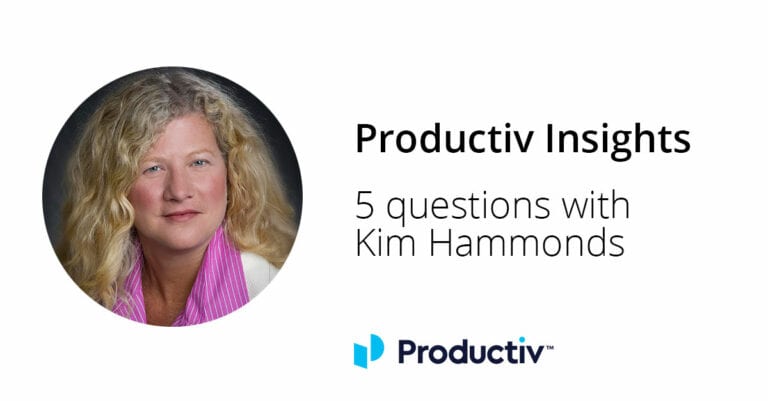
Productiv Insights: Five Questions With Kim Hammonds
Productiv Insights: Five Questions With Kim Hammonds

One of our advisors, Kim Hammonds, serves on the board of directors of Box, Zoom, Red Hat, Cloudera, and Tenable. Previously, she served as the Chief Operating Officer of Deutsche Bank and was the CIO at that organization as well as the Global CIO of Boeing and of two divisions of Ford Motor Company. Recently, she was kind enough to sit down with me to chat about trends she sees in the worlds of enterprise software from a CIO’s perspective, and we’re glad to share her thoughts with you in Q&A form below.
— Jody Shapiro, co-founder and CEO, Productiv
Jody Shapiro: What were your top criteria for evaluating enterprise software solutions when you were a CIO?
Kim Hammonds: I always looked for software that could help me solve big problems. That meant having truly innovative functionality, and the benefits that come with that. Those benefits are often an extension of the vendor’s vision, which is important to understand, and that also means I evaluated the quality of the executive team presenting that vision. I would look for a CEO with vision, and a high quality team that understood and had empathy for the work I was doing. I’ve found that a company’s vision often maps to its ambitions, as the best applications often come from growth companies attacking big market opportunities.
I also would look at the number and roles of the employees who can actually use an application, and I thought about how long it would take for it to start delivering value. Lastly, in an ideal world, deploying or integrating a new solution or switching from an existing solution doesn’t add complexity to an IT environment, so I would look for ease of integration.
JS: What do you view as the biggest recent transformations in software?
KH: Every company in the world is thinking through how their customer experiences are changing, how their business models are changing, and how they are going to use technology as a competitive advantage. Software is evolving in every company with SaaS being adopted faster, dev/ops teams deploying internal software in agile sprints every week or even daily, and data that was once on-premise moving to hybrid and public cloud environments. CIOs are trying to get everyone on SaaS because they don’t want all the underlying infrastructure. Half the enterprise cost of IT in large corporations is on the running of infrastructure – the data centers, the servers, the storage, the end user computing devices, etc. CIOs are incentivized to adopt hybrid cloud computing, public cloud computing, and SaaS, because it takes the cost structure down.
Over the past five years, a big transformation has been led by the success of SaaS vendors’ sales and marketing efforts. That has given them many vectors to enter the enterprise that aren’t always via the CIO, which has drastically increased the number of applications in use in the enterprise. Departments and influential end users became the internal champions for some of the vendors we now read in IPO headlines.
Most recently, I’d say a transformation is being driven by the data that is available from SaaS APIs. CIOs can learn a lot about how their enterprises are using applications from that data. With the right tools, they can surface powerful trends in how employees are actually engaging with applications, right down to the feature level. This type of insight around engagement becomes invaluable to CIOs in renewal or true-up discussions or when determining which direction to go when consolidating redundant applications.
JS: What do you view as the top investment priorities for CIOs right now?
KH: Hybrid and public cloud computing, along with cybersecurity, are big right now, as are SaaS applications for office productivity, collaboration, and conferencing.
It’s important to view investments beyond a technology lens, though. When CIOs make investments in software, it’s because they want to deliver applications and business improvements faster. They want to use data as a competitive advantage and drive new customer experiences. They want to take best practices that might have been developed in isolated silos in the enterprise and bring them to everyone using an application, which encourages employee productivity.
CIOs also increasingly look at software as part of an investment portfolio. That portfolio needs to be reallocated from time to time, so they’re rightsizing existing investments so they can reinvest in the future.
JS: When evaluating different enterprise software solutions, what internal audiences do you think CIOs should keep top of mind?
KH: Software touches everyone in the enterprise, so there are many. Functional leaders are an important audience, and CIOs want to be viewed as business partners by those leaders, so it’s important to work closely with them. It’s also important to keep fingers on the pulse of what departmental leaders and individual employees need and want, because not only are they the end users, they sometimes explore their own solution strategies, and may have even purchased limited deployments of some SaaS via corporate cards.
In the modern enterprise, the C-suite is critically important as well. C-level executives who used to view software as a cost center increasingly think of software as an investment that delivers enterprise returns.
JS: How do you suggest CIOs ignore hype cycles and focus on choosing solutions that their organizations truly need and will benefit from?
KH: Focus on how to use process optimization to improve the customer experience and help change the company. Listen to your business partners within the enterprise to determine what they really need, and put that in the context of vendors’ visions so you can build new business models together. Adopt tools that can measure what employees are actually doing in order to generate productivity rather than simply quantify what has been deployed to them, and use that to influence your decisions.